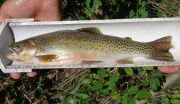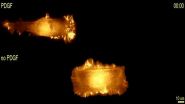(Press-News.org) A new paper from the Wildlife Conservation Society, Montana State University, Montana Department of Fish, Wildlife and Parks, and the U.S. Geological Survey looks at the feasibility of electrofishing to selectively remove invasive trout species from Montana streams as an alternative to using fish toxicants known as piscicides that effect all gill-breathing organisms.
Westslope Cutthroat Trout (WCT) have experienced severe declines throughout much of their historical range. One major reason for this decline is the current competitive advantages enjoyed by non-native Brook Trout that are displacing WCT from their habitat.
Due to this ongoing dynamic, data indicate that the probability of WCT persisting for the next century is low without intervention to remove non-native fish. The use of piscicides, such as rotenone or antimycin, to eradicate these fish concerns fish managers and the public because of the loss of native fish during treatments. Fortunately, most studies have shown that impacts from these piscicides on aquatic communities are relatively short-term.
"Piscicides are a valuable tool to remove non-native fish," said Wildlife Conservation Society Ecologist Brad Shepard. "But where non-native and native fish co-exist in smaller streams, a potential alternative method, electrofishing, can be used to remove specific unwanted species, while reducing impacts on WCT or other native fish and macro-invertebrates."
To provide guidance on circumstances where this method may be a feasible option, the authors evaluated conditions and costs associated with using backpack electrofishing to remove Brook Trout from several Northern Rocky Mountain streams that also support WCT.
The scientists selected six study streams located throughout the upper Missouri River basin in Montana, recording stream parameters such as stream size, vegetation density, substrate, and more.
Trout populations within each treatment reach were isolated by fish barriers. The fish were shocked by a crew member wearing a backpack "shocker" using a wand anode while dragging a cable cathode. A second crewmember followed the shocker and netted the temporarily stunned fish. While the non-native species were removed, the native fish were returned.
Brook trout were successfully eradicated over a period of 4-8 years from four of six treatment sites that together totaled a distance of 10.8 km. The number of fish removed ranged from 1,627 in Staubach Creek to 7,936 in Muskrat Creek. Two other streams, Craver and Spring Creeks, contained dense willow and alder vegetation, and were excluded because of poor initial electrofishing efficiencies.
Other Findings:
Eradication of Brook Trout using electrofishing in the two smaller streams (where channel clearing was not required) cost about $3,500 to $5,500 per kilometer (about the cost of piscicide treatment). Where extensive clearing of the stream was necessary, as was the case with the more densely vegetated White Creek, electrofishing costs rose to $8,000 to $9,000 per kilometer.
The scientists found that multiple removal treatments within a shorter period of time (i.e. 3 or 4 years) was more effective than single annual treatments over a longer span (6 or more years).
The scientists took advantage of the fact that Brook Trout aggregate during winter and before and during their spawning in the fall. Focusing efforts on adult fish at these times reduced numbers of offspring in subsequent seasons.
Because trout select beaver pond habitats (where deposited silt makes wading dangerous and turbidity makes it difficult to see stunned fish), the authors say that treatment with piscicides is "probably the only viable alternative where large beaver ponds are present."
Overall, the scientists concluded that electrofishing was a viable method for eradicating Brook Trout in small streams and could be done in a period as short as three years if multiple removals were conducted each year. This is an attractive alternative particularly in situations where populations of native fish live in the same location as non-native fish as "electrofishing will allow for the preservation of the native fish."
Piscicides may be the only viable alternative for larger streams (>3m width), or in streams covered by dense woody vegetation or with beaver ponds where turbidity and cover make electrofishing difficult or impossible. The scientists noted that further studies would be necessary to determine if two crews working simultaneously could get the job done in larger streams.
Cost estimates in the comparison did not include barrier construction, environmental assessment, and public involvement costs because these activities are needed for any nonnative eradication effort. However, environmental assessment and public involvement costs would likely be higher for piscicide eradication projects.
INFORMATION:
"Factors Influencing Successful Eradication of Nonnative Brook trout from Four Small Rocky Mountain Streams Using Electrofishing" appears in the current edition of the North American Journal of Fisheries Management. Authors include: Bradley B. Shepard of the Wildlife Conservation Society, Montana State University and Montana Department of Fish, Wildlife and Parks; Lee M. Nelson of Montana Department of Fish,Wildlife and Parks; Mark L. Taper of Montana State University; and Alexander V. Zaleof the U.S. Geological Survey.
For further information on this story, or to talk with Brad Shepard, please contact Scott Smith at 718-220-3698 or email ssmith@wcs.org.
Wildlife Conservation Society (WCS)
MISSION: WCS saves wildlife and wild places worldwide through science, conservation action, education, and inspiring people to value nature. VISION: WCS envisions a world where wildlife thrives in healthy lands and seas, valued by societies that embrace and benefit from the diversity and integrity of life on earth. To achieve our mission, WCS, based at the Bronx Zoo, harnesses the power of its Global Conservation Program in more than 60 nations and in all the world's oceans and its five wildlife parks in New York City, visited by 4 million people annually. WCS combines its expertise in the field, zoos, and aquarium to achieve its conservation mission. Visit: http://www.wcs.org. Follow: @thewcs.
Are Montana's invasive fish in for a shock?
Study finds that electrofishing can be used to target non-native species and may be a viable alternative to non-specific fish toxicant treatments of small streams
2014-10-06
ELSE PRESS RELEASES FROM THIS DATE:
Controlling Ebola in communities is critical factor in containing outbreaks
2014-10-06
Reducing community transmission and changing behaviour in communities is key to containing Ebola outbreaks, according to new research into the first known outbreak of the virus in 1976 by researchers at the London School of Hygiene & Tropical Medicine and Fogarty International Center at the National Institutes of Health.
The study authors include Professor Peter Piot and Dr Joel Breman, who travelled to Zaire (now the Democratic Republic of Congo), to investigate the first outbreak in 1976. The study, published in Epidemics, also found that if the people in the affected ...
Study of identical twins reveals type 2 diabetes clues
2014-10-06
By studying identical twins, researchers from Lund University in Sweden have identified mechanisms that could be behind the development of type 2 diabetes. This may explain cases where one identical twin develops type 2 diabetes while the other remains healthy.
The study involved 14 pairs of identical twins in Sweden and Denmark. One twin had type 2 diabetes and the other was healthy.
"Twins are a good model for finding mechanisms, but the results are applicable to all", said Emma Nilsson, who carried out the study with Charlotte Ling.
We know that fat tissue can ...
Link between breast implants and cancer under investigation
2014-10-06
Worldwide there have been 71 documented cases of patients with anaplastic large cell lymphoma (ALCL) in which researchers suspected breast implants to be the cause. ALCL is normally found in the lymph nodes, as well as in skin, lung, liver and soft tissue, but not usually in the breast. Cases in which ALCL developed in the breast region almost exclusively involved patients who have had breast surgery. In these cases, ALCL developed around ten years after the operation. The tumours grew in the scar tissue around the implant.
Breast implants are generally safe and studies ...
Atmospheric chemistry hinges on better physics model
2014-10-06
New theoretical physics models could help us better grasp the atmospheric chemistry of ozone depletion. Indeed, understanding photoabsorption of nitrous oxide (N2O) — a process which involves the transfer of the energy of a photon to the molecule — matters because a small fraction of N2O reacts with oxygen atoms in the stratosphere to produce among others nitric oxide (NO). The latter participates in the catalytic destruction of ozone (O3). Now, new theoretical work unveils the actual dynamic of the photoabsorption of nitrous oxide molecules. These findings by Mohammad ...
Basel scientists are bringing cells on the fast track
2014-10-06
VIDEO:
The cell stimulated with the growth factor PDGF (upper cell) migrates targeted in only one direction on its track, while the not stimulated cell (lower cell) changes its direction of...
Click here for more information.
During cancer metastasis, immune response or the development of organisms, cells are moving in a controlled manner through the body. Researchers from the Department of Biomedicine at the University of Basel discovered novel mechanisms of cell migration by ...
Liquid DNA behind virus attacks
2014-10-06
Viruses can convert their DNA from solid to fluid form, which explains how viruses manage to eject DNA into the cells of their victims. This has been shown in two new studies carried out by Lund University in Sweden.
Both research studies are about the same discovery made for two different viruses, namely that viruses can convert their DNA to liquid form at the moment of infection. Thanks to this conversion, the virus can more easily transfer its DNA into the cells of its victim, which thus become infected. One of the studies investigated the herpes virus, which infects ...
Nanoparticles break the symmetry of light
2014-10-06
This news release is available in German.
How can a beam of light tell the difference between left and right? At the Vienna University of Technology (TU Wien) tiny particles have been coupled to a glass fibre. The particles emit light into the fibre in such a way that it does not travel in both directions, as one would expect. Instead, the light can be directed either to the left or to the right. This has become possible by employing a remarkable physical effect – the spin-orbit coupling of light. This new kind of optical switch has the potential to revolutionize ...
Tumors might grow faster at night
2014-10-06
They emerge at night, while we sleep unaware, growing and spreading out as quickly as they can. And they are deadly. In a surprise finding that was recently published in Nature Communications, Weizmann Institute of Science researchers showed that nighttime is the right time for cancer to grow and spread in the body. Their findings suggest that administering certain treatments in time with the body's day-night cycle could boost their efficiency.
This finding arose out of an investigation into the relationships between different receptors in the cell – a complex network ...
Researchers redefine hypothesis on holes in the brain
2014-10-06
Over the years, researchers have described how some of the body's cells have giant channels – a kind of holes that completely uncritically allow both small and large molecules to penetrate into and out of the cell. The hypothesis is that these normally closed gatekeeper proteins in the cell membrane allow unrestricted access in the event of diseases such as myocardial infarction, stroke or Alzheimer's. If the hypothesis was correct, the obvious choice would be to look for novel drugs to block the relevant membrane proteins and in this way cure or prevent disease.
New ...
Tracing our ancestors at the bottom of the sea
2014-10-06
A specialist group of European researchers are studying the remains of prehistoric human settlements which are now submerged beneath our coastal seas. Some of these drowned sites are tens of thousands of years old. From the progressive discovery and analysis of these prehistoric remains, a new scientific field has emerged, combining the expertise from many disciplines including archaeology, oceanography and the geosciences. The new field is called Continental Shelf Prehistoric Research.
This rapidly evolving research field is the focus of a new European Marine Board ...
LAST 30 PRESS RELEASES:
Why nail-biting, procrastination and other self-sabotaging behaviors are rooted in survival instincts
Regional variations in mechanical properties of porcine leptomeninges
Artificial empathy in therapy and healthcare: advancements in interpersonal interaction technologies
Why some brains switch gears more efficiently than others
UVA’s Jundong Li wins ICDM’S 2025 Tao Li Award for data mining, machine learning
UVA’s low-power, high-performance computer power player Mircea Stan earns National Academy of Inventors fellowship
Not playing by the rules: USU researcher explores filamentous algae dynamics in rivers
Do our body clocks influence our risk of dementia?
Anthropologists offer new evidence of bipedalism in long-debated fossil discovery
Safer receipt paper from wood
Dosage-sensitive genes suggest no whole-genome duplications in ancestral angiosperm
First ancient human herpesvirus genomes document their deep history with humans
Why Some Bacteria Survive Antibiotics and How to Stop Them - New study reveals that bacteria can survive antibiotic treatment through two fundamentally different “shutdown modes”
UCLA study links scar healing to dangerous placenta condition
CHANGE-seq-BE finds off-target changes in the genome from base editors
The Journal of Nuclear Medicine Ahead-of-Print Tip Sheet: January 2, 2026
Delayed or absent first dose of measles, mumps, and rubella vaccination
Trends in US preterm birth rates by household income and race and ethnicity
Study identifies potential biomarker linked to progression and brain inflammation in multiple sclerosis
Many mothers in Norway do not show up for postnatal check-ups
Researchers want to find out why quick clay is so unstable
Superradiant spins show teamwork at the quantum scale
Cleveland Clinic Research links tumor bacteria to immunotherapy resistance in head and neck cancer
First Editorial of 2026: Resisting AI slop
Joint ground- and space-based observations reveal Saturn-mass rogue planet
Inheritable genetic variant offers protection against blood cancer risk and progression
Pigs settled Pacific islands alongside early human voyagers
A Coral reef’s daily pulse reshapes microbes in surrounding waters
EAST Tokamak experiments exceed plasma density limit, offering new approach to fusion ignition
Groundbreaking discovery reveals Africa’s oldest cremation pyre and complex ritual practices
[Press-News.org] Are Montana's invasive fish in for a shock?Study finds that electrofishing can be used to target non-native species and may be a viable alternative to non-specific fish toxicant treatments of small streams


